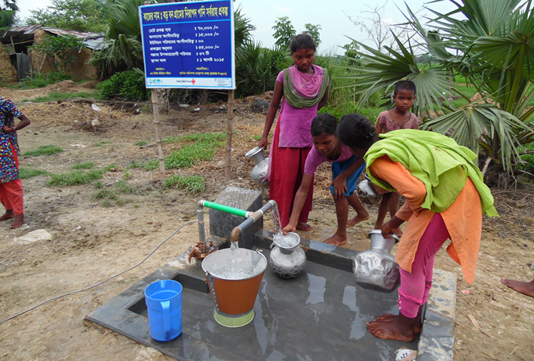RAJSHAHI, June 12, 2019 (BSS) – Submersible pumps have brought boon for the
people of drought-prone Barind area here, supplying safe drinking water to
over 2.80 lakh marginalized people including 68,000 ethnic minority ones.
Apart from this, more eight lakh people in 38 Union Parishads (UPs) and
three pourasabhas in Rajshahi, Naogaon and Chapainawabganj districts are also
being benefited by it.
DASCOH Foundation and Swiss Red Cross jointly run these pumps under its
‘Integrated Water Resource Management (IWRM)’ project with around Taka 3.50
crore financial supports from Swiss Agency for Development and Cooperation-
SDC.
In order to ensuring safe drinking water for Barind under-privileged
people, 344 submersible pumps and 44,228 feet sub-surface pipelines have, so
far, been installed in 312 drought-hit villages since July, 2015.
Five solar panels were also established to operate five pumps in the
villages still being remained beyond power network.
Around 5,400 inhabitants of 1,200 households have been possible to be
reached water at their door-steps due to installation of a deep tube-well, a
35,000-liter capacity overhead tank and 6,000-meter pipelines at Bidirpur
village under Godagari Upazila.
“We have set a target to bring a total of 12.58 lakh people under the safe
drinking water supply coverage by June, 2022,” Jahangir Alam Khan, Assistant
Coordinator of IWRM Project told BSS here on Tuesday.
He said the initiative has been taken to supply safe drinking water to the
poor and vulnerable villagers’ round-the-year.
“We are very much happy after getting safe drinking water,” said Amrita
Kisku, 42, wife of Shital Kisku of Uchadanga village under Tanore upazila in
the district.
Anila Kisku, 38, wife of Sunil Kisku of the same village, also expressed
her happiness over the water supply system. She is now getting requisite
water for her nine-member family.
Lutfor Rashid Haider, Chairman of Tanore Upazila, said the poor and
underprivileged people in the drought-hit area are getting safe drinking
water for the IWRM Project.
In the wake of inadequate aquifer recharge, groundwater level is declining
alarmingly in the high Barind tract, posing a serious threat to its farming
sector besides living and livelihood conditions of local people, he said.
Lifting underground water through deep tube-wells is becoming tougher
during the dry season day by day while options for surface water are also
very limited, he added.
He, however, said that the submersible water supply system has become a
blessing for the drought-affected people.
Akramul Haque, Chief Executive Officer of DASCOH Foundation, said the
scheme aims to increase the availability of water for disadvantaged people in
the Barind areas and protect them from health risks related to use of unsafe
water.
Prof Chowdhury Sarwar Jahan of Department of Geology and Mining in Rajshahi
University referred to various research findings, saying there is a shortage
of drinking water in the region during dry season and the problem has become
acute for the last couple of years.
He said villagers cannot withdraw groundwater through tube- wells as the
water level goes down abnormally during dry season.
The excessive use of groundwater for irrigation and the adverse impact of
climate change are putting local people in trouble, he added.
In this regard, submersible pumps are contributing a lot to reduce the
acute crisis of drinking water in the drought-prone area



